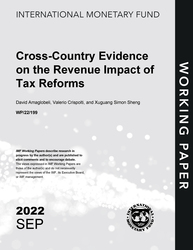
Cross-Country Evidence on the Revenue Impact of Tax Reforms
Cross-Country Evidence on the Revenue Impact of Tax Reforms
READ MORE...
Volume/Issue:
Volume 2022
Issue 199
Publication date: September 2022
ISBN: 9798400222023
$20.00
Add to Cart by clicking price of the language and format you'd like to purchase
Available Languages and Formats
| English |
Prices in red indicate formats that are not yet available but are forthcoming.
Topics covered in this book
This title contains information about the following subjects.
Click on a subject if you would like to see other titles with the same subjects.
Economics- Macroeconomics , Public Finance , Taxation - General , Economics / General , corporate income tax , personal income tax , value added taxes , social security contributions , excise , property taxes , tax reforms , revenue yield , revenue impact , Tax-to-GDP ratio , rate change , SSC rate hike , Tax collection , Value-added tax
Summary
Many countries face the challenge of raising additional tax revenues without hurting economic growth. Comprehensive, cross-country information on the revenue impact of tax policy changes can thus support informed decision-making on viable reforms. We assess the likely revenue impact of various tax policy changes based on a sample of 21 advanced and emerging market economies, using granular information from the IMF Tax Policy Reform Database v.4.0. Our findings suggest that the revenue yield of a tax policy change varies significantly depending on the tax instrument adopted (e.g., VAT or personal income tax) and the nature of the change (i.e., rate, base). For example, in our sample, base-broadening changes to personal and corporate income taxes as well as to excise and property taxes have generally a more significant and long-lasting revenue yields than rate changes. By contrast, rate changes appear to have a relatively more significant revenue impact in the case of VAT and social security contributions. We also observe an asymmetry in the revenue impact of most tax policy measures when controlling for the direction of tax changes (i.e., its significance varies depending on whether taxes are increased or decreased). While our results are based on qualitative information of tax policy changes (i.e., dummy variables), the revenue yields of rate measures are not materially different from those that would be obtained using quantitative information on the size of the change.



